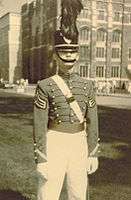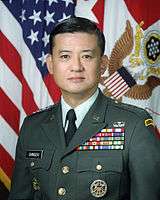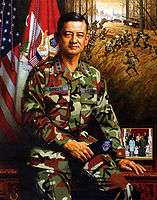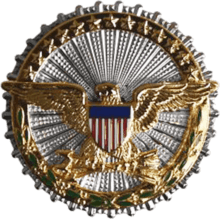Eric Shinseki
Eric Ken Shinseki (/ʃᵻnˈsɛki/; born November 28, 1942) is a retired United States Army general who served as the seventh United States Secretary of Veterans Affairs (2009–2014).[4] His final U.S. Army post was as the 34th Chief of Staff of the Army (1999–2003). Shinseki is a veteran of two tours of combat in the Vietnam War, in which he was awarded three Bronze Stars for valor and two Purple Hearts.[5] He was the first Asian-American four-star general, and the first Asian-American Secretary of Veterans Affairs.[6]
Early life and education

Shinseki was born in Lihue, Kauaʻi, in the then Territory of Hawaii, to an American family of Japanese ancestry. His grandparents emigrated from Hiroshima to Hawaii in 1901.[7] He grew up in a sugarcane plantation community on Kaua'i and graduated from Kaua'i High and Intermediate School in 1960.[8] While attending Kaua'i he was active in the Boy Scouts and served as class president.[8] As a boy, Shinseki learned that three of his uncles had served in the 442nd Infantry Regiment, a unit of Japanese Americans that became one of the most decorated fighting units in United States history.[9] Motivated by his uncles' example, he attended the United States Military Academy and graduated in 1965 with a bachelor of science degree and a commission as a second lieutenant. He earned a Master of Arts degree in English Literature from Duke University. He was also educated at the Armor Officer Advanced Course, the United States Army Command and General Staff College, and the National War College.
Military service


Shinseki served in a variety of command and staff assignments in the Continental United States and overseas, including two combat tours with the 9th and 25th Infantry Divisions in the Republic of Vietnam as an artillery forward observer and as commander of Troop A, 3rd Squadron, 5th Cavalry Regiment. During one of those tours while serving as a forward artillery observer, he stepped on a land mine, which blew the front off one of his feet; after spending almost a year recovering from his injuries, he returned to active duty in 1971.[5]
He has served at Schofield Barracks, Hawai'i with Headquarters, United States Army Hawaii, and Fort Shafter with Headquarters, United States Army Pacific. He has taught at the U.S. Military Academy’s Department of English. During duty with the 3rd Armored Cavalry Regiment at Fort Bliss, Texas, he served as the regimental adjutant and as the executive officer of its 1st Squadron.
Shinseki’s ten-plus years of service in Europe included assignments as Commander, 3rd Squadron, 7th Cavalry, 3rd Infantry Division (Schweinfurt); Commander, 2nd Brigade, 3rd Infantry Division (Kitzingen); Assistant Chief of Staff, G3, 3rd Infantry Division (Operations, Plans and Training) (Würzburg); and Assistant Division Commander for Maneuver, 3rd Infantry Division (Schweinfurt). The 3rd ID was organized at that time as a heavy mechanized division. He also served as Assistant Chief of Staff, G3 (Operations, Plans, and Training), VII Corps (Stuttgart). Shinseki served as Deputy Chief of Staff for Support, Allied Land Forces Southern Europe (Verona), an element of the Allied Forces Southern Europe. From March 1994 to July 1995, Shinseki commanded the 1st Cavalry Division at Fort Hood, Texas. In July 1996, he was promoted to lieutenant general and became Deputy Chief of Staff for Operations and Plans, United States Army. In June 1997, Shinseki was appointed to the rank of general before assuming duties as Commanding General, Seventh United States Army; Commander, Allied Land Forces Central Europe; and Commander, NATO Stabilization Force in Bosnia and Herzegovina. Shinseki became the Army's 28th Vice Chief of Staff on November 24, 1998, then became its 34th Chief of Staff on June 22, 1999.[10] Shinseki retired on June 11, 2003 at the end of his four-year term. His Farewell Memo contained some of his ideas regarding the future of the military.[11] At that time, General Shinseki retired from the Army after 38 years of military service.
As of 2009, General Shinseki was the highest-ranked Asian American in the history of the United States.[12] Additionally, as of 2004, he is the highest-ranked Japanese American to have served in the United States Armed Forces.[13]
Army Chief of Staff

During his tenure as Army Chief of Staff, Shinseki initiated an innovative but controversial plan to make the Army more strategically deployable and mobile in urban terrain by creating Stryker Interim-Force Brigade Combat Teams.[14] He conceived a long term strategic plan for the Army dubbed Objective Force, which included a program he designed, Future Combat Systems.[15] One other controversial plan that Shinseki implemented was the wearing of the black beret for all Army personnel.[16] Prior to Shinseki implementing this policy, only the United States Army Rangers could wear the black beret. When the black beret was given to all soldiers and officers, the Rangers moved to the tan beret.
Shinseki publicly clashed with Secretary of Defense Donald Rumsfeld during the planning of the war in Iraq over how many troops the United States would need to keep in Iraq for the postwar occupation of that country. As Army Chief of Staff, General Shinseki testified to the U.S. Senate Armed Services Committee on February 25, 2003 that "something in the order of several hundred thousand soldiers" would probably be required for postwar Iraq. This was an estimate far higher than the figure being proposed by Secretary Rumsfeld in his invasion plan, and it was rejected in strong language by both Rumsfeld and his Deputy Secretary of Defense, Paul Wolfowitz, who was another chief planner of the invasion and occupation.[17] From then on, Shinseki's influence on the Joint Chiefs of Staff reportedly waned.[18] Critics of the Bush Administration alleged that Shinseki was forced into early retirement as Army Chief of Staff because of his comments on troop levels; however, his retirement was announced nearly a year before those comments.[19]
When the insurgency took hold in postwar Iraq, Shinseki's comments and their public rejection by the civilian leadership were often cited by those who felt the Bush administration deployed too few troops to Iraq.[20] On November 15, 2006, in testimony before Congress, CENTCOM Commander Gen. John Abizaid said that General Shinseki had been correct that more troops were needed.[20]
Post-military career

Shinseki has served as a director for several corporations: Honeywell International and Ducommun, military contractors; Grove Farm Corporation; First Hawaiian Bank;[21] and Guardian Life Insurance Company of America.[22] He is a member of the Advisory Boards at the Center for Public Leadership, John F. Kennedy School of Government, Harvard University, and to the U.S. Comptroller General. He is a member of the Council on Foreign Relations, the Atlantic Council of the United States, and the Association of the United States Army.[23]
United States Secretary of Veterans Affairs (2009–2014)
On December 7, 2008, then-President-elect Barack Obama announced at a press conference in Chicago that he would nominate Shinseki to become the Secretary of Veterans Affairs.[24] He was unanimously confirmed by the United States Senate on January 20, 2009, and sworn in the next day.[25]
Veterans Health Administration scandal
In May 2014, Shinseki was embroiled in a scandal involving the Veterans Health Administration, which is a component of the United States Department of Veterans Affairs. Questions involving substandard timely care and false records covering up related timelines had come to light, involving treatment of veterans in a number of VA hospitals.[26][27] On May 30, 2014, President Obama announced that he had accepted Shinseki's resignation as Secretary.[28][29] Shinseki said he couldn't explain the lack of integrity among some leaders in VA healthcare facilities. "That breach of integrity is irresponsible, it is indefensible, and unacceptable to me." He said he could not defend what happened because it was indefensible, but he could take responsibility for it and he would.[30] Following Shinseki's resignation, it became the first time since 2000, that an Asian American has not been on the Cabinet of the United States.[31]
In an interview with retired General Peter W. Chiarelli, journalist Robert Siegel described the situation as "a case of a very, very good man who's run up against some pretty terrible problems in his job," to which Chiarelli responded, "I don't look up to any man more than I look up to Eric Shinseki."[32]
Awards, decorations, and badges
Shinseki was awarded the following medals, ribbons, badges, and tabs:[33][34]
| Defense Distinguished Service Medal[35] (with one oak leaf cluster)[36] | |
| Army Distinguished Service Medal[35] | |
| Navy Distinguished Service Medal[37] | |
| Air Force Distinguished Service Medal[37] | |
| Coast Guard Distinguished Service Medal[37] | |
| Legion of Merit (with Oak Leaf Cluster)[35] | |
| Bronze Star (with "V" Device and two Oak Leaf Clusters)[35] | |
| Purple Heart (with Oak Leaf Cluster)[35] | |
| Defense Meritorious Service Medal[35] | |
| Meritorious Service Medal (with two Oak Leaf Clusters)[35] | |
| Air Medal[35] | |
| Army Commendation Medal (with Oak Leaf Cluster)[38] | |
| Army Achievement Medal[38] | |
| National Defense Service Medal with Service star | |
| Vietnam Service Medal with four Service stars | |
| Armed Forces Service Medal | |
| Army Service Ribbon | |
| Army Overseas Service Ribbon | |
| NATO Medal for Former Yugoslavia | |
| Vietnam Campaign Medal |
| |
Parachutist Badge |
| |
Ranger Tab |
 |
Office of the Secretary of Defense Identification Badge |
 |
Joint Chiefs of Staff Identification Badge |
 |
Army Staff Identification Badge |
| |
Four Overseas Service Bars |
Family
Shinseki is married to his high school sweetheart, Patricia; they are the parents of two children, Lori and Ken.[8] He also has seven grandchildren.[39]
Notes
- ↑ Gregg K. Kakesako (June 21, 1999). "Native son joining ranks of eminent Army leaders". Honolulu Star Bulletin. Retrieved November 13, 2012.
- ↑ "Award citations, Eric Ken Shinseki". Hall of Valor. Military Times. Retrieved April 20, 2015.
- ↑ "Biography, General Eric K. Shinseki". Campaign for the National Museum of the United States Army. Army Historical Foundation. Retrieved April 20, 2015.
- ↑ Jaffe, Greg; O'Keefe, Ed (30 May 2014). "Obama accepts resignation of VA Secretary Shinseki". Washington Post. Retrieved 19 August 2014.
- 1 2 Eric Shinseki (May 12, 2009). "Remarks by Secretary Eric K. Shinseki, 2009 Secretary's Awards for Excellence in Nursing". U.S. Department of Veterans Affairs.
- ↑ "Overseas Contigency Operations Profiles". Asia Pacific Americans in the United States Army. United States Army. Retrieved 19 August 2014.
- ↑ Obata, Hiroshi. 両祖父母は広島出身 ("Shinseki: both grandparents are from Hiroshima"). Hiroshima Peace Media (Japan). January 30, 2009
- 1 2 3 Sauer, Bobbie Kyle (18 December 2008). "10 Things You Didn't Know About Gen. Eric Shinseki". U.S. News & World Report. Retrieved 9 April 2015.
- ↑ "Eric K. Shinseki". Encyclopaedia Brittanica. Retrieved May 30, 2014.
- ↑ Fahrig, Jody T. (June 23, 1999). "Army welcomes Shinseki as new chief". Army News Service. Archived from the original on March 12, 2008. Retrieved May 27, 2006.
- ↑ Shinseki, Eric K (June 10, 2003). "End of Tour Memorandum" (PDF). The Washington Post Company. Retrieved December 7, 2008.
- ↑ Thom Shanker (January 14, 2009). "A Second Act for General Shinseki". New York Times. Retrieved February 6, 2012.
- ↑ Gregg K. Kakesako (March 31, 2004). "An Inspiration for a Generation". Honolulu Star Bulletin. Retrieved February 6, 2012.
- ↑ Thom Shanker (October 29, 2002). "Army Takes on Critics of an Armored Vehicle". New York Times. Retrieved March 20, 2011.
- ↑ "Objective Force is Needed for Relevancy". AUSA News. Association of the United States Army. April 1, 2001. Retrieved March 20, 2011.
- ↑ "Beret battle: Army approves color change". Amarillo Globe=News. March 16, 2001. Retrieved March 20, 2011.
- ↑ Schmitt, Eric (February 28, 2003). "Pentagon Contradicts General on Iraq Occupation Force's Size". The New York Times. Retrieved April 4, 2012.
- ↑ Shanker, Thom "New Strategy Vindicates Ex-Army Chief Shinseki", New York Times, January 12, 2007.
- ↑ CNN Political Unit. CNN Political Unit debate fact check. CNN.com. October 9, 2004.
- 1 2 Ricks, Thomas E.; Ann Scott Tyson (November 16, 2006). "Abizaid Says Withdrawal Would Mean More Unrest". Washington Post. p. A22. Retrieved December 13, 2006.
General [Eric] Shinseki was right that a greater international force contribution, U.S. force contribution and Iraqi force contribution should have been available immediately after major combat operations.
- ↑ Rucker, Philip; Thomas E. Ricks (December 6, 2008). "Shinseki Slated to Head VA, Obama Confirms". Washington Post. Retrieved December 7, 2008.
- ↑ "Shinseki biography". Forbes. Retrieved December 7, 2008.
- ↑ "The Purpose Prize: Shinseki". Retrieved December 7, 2008.
- ↑ "Obama: No one 'more qualified' than Shinseki to head VA". CNN. December 7, 2008. Retrieved December 7, 2008.
- ↑ Abrams, Jim (January 20, 2009). "Senate confirms 6 cabinet secretaries". Real Clear Politics. Retrieved January 10, 2013.
- ↑ Shinseki 'mad as hell' about VA allegations, but won't resign
- ↑ "VA's top health official resigns amid scandal over delays in vets' care | Military Times". militarytimes.com. 2014-05-15. Retrieved 2014-05-19.
- ↑ "Embattled VA chief Shinseki resigns". USA Today. 2014-05-30. Retrieved 2014-05-30.
- ↑ "Veterans Secretary Eric Shinseki resigns". CNN. 2014-05-30. Retrieved 2014-05-30.
- ↑ "US president accepts with 'regret' Veterans Affairs chief's resignation". Chicago Chronicle. Retrieved 31 May 2014.
- ↑ Mak, Tim (1 June 2014). "There Are No Asian-Americans In The Cabinet For The First Time Since 2000". The Daily Beast. Retrieved 19 August 2014.
- ↑ Siegel, Robert (2014-05-30). "Retired Army Gen. On Shinseki: 'I Don't Look Up To Any Man More'". NPR. Retrieved 2014-05-31.
- ↑ "Eric K. Shinseki". Office of Public and Intergovernmental Affairs. United States Department of Veterans Affairs. Archived from the original on September 15, 2014. Retrieved January 29, 2013.
- ↑ "Overseas Contingency Operations". Asian Pacific Americans in the United States Army. United States Army. Retrieved January 28, 2013.
"Chief of Staff of the Army Official Portrait". Army Leadership. United States ARmy. June 24, 2001. Archived from the original on April 29, 2003. Retrieved January 29, 2013.
"S.RES.190 – Commending General Eric Shinseki of the United States Army for his outstanding service and commitment to excellence. (Agreed to Senate – ATS)". www.congress.gov. Library of Congress.Whereas General Shinseki has been awarded the Defense Distinguished Service Medal, Distinguished Service Medal, Legion of Merit (with oak leaf clusters), Bronze Star Medal with `V' Device (with 2 oak leaf clusters), Purple Heart (with oak leaf cluster), Meritorious Service Medal (with 2 oak leaf clusters), Air Medal, Army Commendation Medal (with oak leaf cluster), Army Achievement Medal, Parachutist Badge, Ranger Tab, Office of the Secretary of Defense Identification Badge, Joint Chiefs of Staff Identification Badge, and the Army Staff Identification Badge;
- 1 2 3 4 5 6 7 8 Eric K. Shinseki: Former Secretary of Veterans Affairs, Department of Veterans Affairs Biography, About.com, U.S. Government, by Robert Longley, last accessed 13 July 2013
- ↑ "Eric Ken Shinseki". Hall of Valor. Gannett. Retrieved 13 March 2015.
Tran, Can (7 December 2008). "Obama Picks Army Gen. Shinseki To Head VA". Digital Journal. Retrieved 14 September 2014. - 1 2 3 "President-Elect Barack Obama Announces General Eric Shinseki as Secretary of Veterans Affairs". The American Presidency Project. UCSB. 7 December 2008. Retrieved 30 August 2014.
- 1 2 General Eric K. Shinseki, Retired Chief of Staff, United States Army, Asian American Network, last accessed 13 July 2014
- ↑ Shane III, Leo (19 June 2013). "Shinseki's style: Determined, quiet". Stars and Stripes. Retrieved 9 April 2015.
References
- VA Official Biography
- Official U.S. Army biography, in Bell, William Gardner. Commanding Generals and Chiefs of Staff 1775–2005: Portraits & Biographical Sketches of the United States Army's Senior Officer, United States Army Center of Military History, 2005. (ISBN 0-16-072376-0)
Further reading
- "Transcript of the Chief of Staff of the Army's Remarks to Soldiers Radio and Television (after the attacks of September 11th)". Army News Service. September 14, 2001. Archived from the original on December 10, 2008. Retrieved January 26, 2013.
- Burlas, Joe (June 10, 2003). "Commentary: Shinseki leaves legacy of irreversible momentum". Army News Service. Archived from the original on December 10, 2008. Retrieved January 26, 2013.
- Dickey, Connie. "Chief of Staff shares his concerns for the soldier and the Army", ARNEWS, June 28, 1999. From media interview 3 days after becoming Army Chief of Staff. (URL retrieved May 27, 2006)
- Moulin, Pierre. " Commentary: Eric Shinseki Gallery", Fort DeRussy – U.S. Army Museum of Hawaii, April 2008. ISBN 978-1-56647-850-2
- Siemieniec, Jack. "Chief of Staff expands on Army Vision", ARNEWS, January 31, 2000. (URL retrieved May 27, 2006)
External links
- Biography at the United States Department of Veterans Affairs
- Appearances on C-SPAN
- "Eric Shinseki collected news and commentary". The New York Times.
- (Works by or about Eric Shinseki in libraries (WorldCat catalog)
- Eric K. Shinseki Collection (while CSA) US Army Heritage and Education Center, Carlisle, Pennsylvania
- Eric K. Shinseki Gallery Fort DeRussy Army Museum of Hawaii
| Military offices | ||
|---|---|---|
| Preceded by William Crouch |
Commanding General of the United States Army Europe 1997–1998 |
Succeeded by Montgomery Meigs |
| Vice Chief of Staff of the United States Army 1998–1999 |
Succeeded by Jack Keane | |
| Preceded by Dennis Reimer |
Chief of Staff of the United States Army 1999–2003 |
Succeeded by Peter Schoomaker |
| Political offices | ||
| Preceded by James Peake |
United States Secretary of Veterans Affairs 2009–2014 |
Succeeded by Sloan Gibson Acting |





